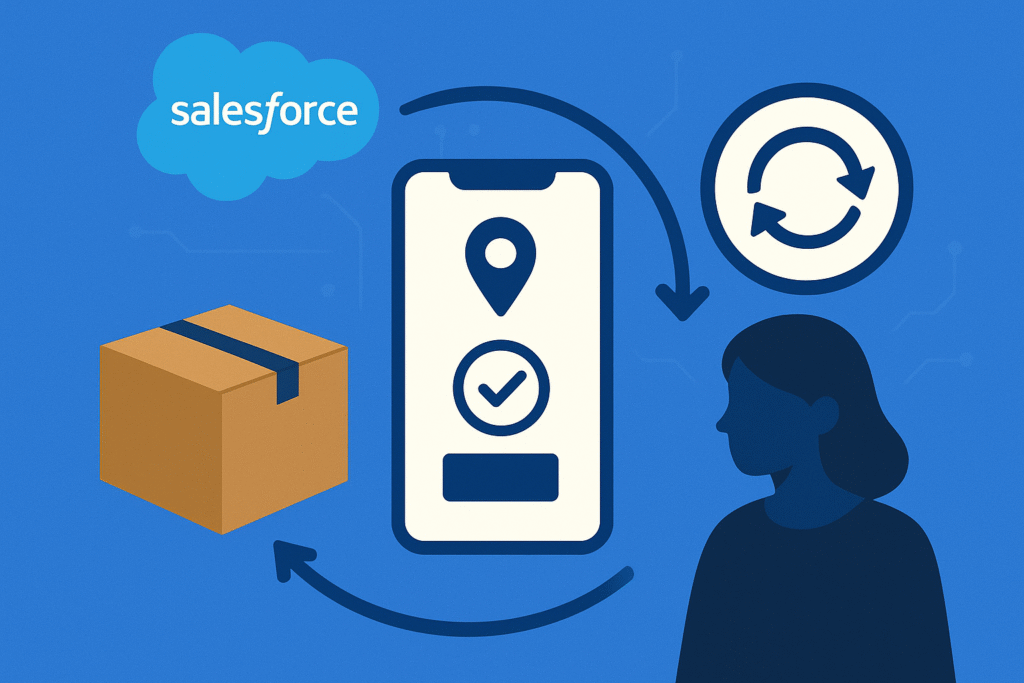Unify Shipping, Tracking & Returns Seamlessly in Salesforce

Introduction: Unify Shipping, Tracking & Returns Seamlessly in Salesforce
Modern businesses know that winning customer work is not done on checkout. The real test begins after ordering. Today’s customers expect immediate shipping confirmation, accurate tracking updates, and easy returns. If these steps are rude, even the best products cannot stop churning.
This is the reason why unifying shipping, tracking, and returns in Salesforce has become necessary. Salesforce is already the spinal cord of sales, service, and customer data and can also manage the after-purchase experience. When logistics and customer service are united under a platform, businesses reduce costs, make customers happy, and build long-term loyalty.
These blog companies look for how these workflows can integrate into Salesforce, the benefits of doing so, the equipment available, and the best methods of success.
Table of Contents
Why the Post-Purchase Journey Matters
Often, businesses invest heavily in lead generation, marketing automation and sales capability but what comes later – delivering delivery experience. Yet, this phase can create or break relationships.
1. Shipping: Customers expect the order to leave the warehouse quickly and without mistakes.
2. Tracking: Transparency makes confidence. Buyers want real-time visibility.
3. Rewards: Simple, flexible policies promote repetitive purchases.
Studies confirm: More than 90% of customers say they are more likely to buy with retailers who offer trouble-free returns, and expect almost all active shipping updates. Salesforce gives businesses a structure to meet these expectations.
Salesforce as the Central Hub
Salesforce is best to integrate customer interactions into a single source of truth. This is provided by extending to logistics:
- Integrated Data: Order, shipment and returns are directly connected to the customer profile.
- Automation: Shipping labels, tracking updates and refund triggers run without intervening.
- Consumer Empowerment: Service representatives and self-service portals provide immediate answers.
- Analysis: Administrators track distribution operations, return rates and reliability of the carrier.
Webstore for order instead of quiet systems, carrier portal for shipping and spreadsheets to the Spreadsheet Salesforce Command Center.
Shipping in Salesforce: Automating Fulfillment
The first step after sale is to deliver the product. By integrating into the salesforce conductor network, this step becomes friction.
How it works:
- Order enters Salesforce (from Commerce Cloud, Shopifi or ERP)
- The system validates the address and selects the best carrier.
- The label is produced immediately in salesforce.
- The customer receives a branded confirmation email.
Benefits:
- No need to log in to a separate conductor portal.
- The error rate is lower due to automation.
- Compatibility in regions and carriers.
For example, a salesforce-enabled retailer can print DHL or FEDEX labels directly from their dashboard and update the customer in seconds.
Tracking: Creating Transparency
Once sent, the tracking is where the customer’s concern begins. Lack of updates often leads to expensive support calls. Salesforce coordination solves this.
How it works:
- Tracking numbers automatically combine with salesfor records.
- Conductive status improvements flow into salesforce in real time.
- Automation sends SMS/email notifications to major landmarks.
- Service cloud agents immediately see the location of the current package.
Benefits:
- Reduce “Where is my order?” Inquiry.
- Active alerts for delays or exceptions.
- Strong trust by transparency.
Imagine a fashion brand using salesforce: When UPS reports delay, cyst.
Returns: Turning Hassles into Loyalty
Returns are inevitable, but they do not need to harm the profitability. In fact, by controlling well, they increase the retention. Salesforce trimates the process from the end to the end.
How it works:
- Customer’s requests are returned by a portal or service agent.
- Salesforce Returns Merchandise Authorization (RMA) and shipping label generates.
- The return package is tracked like an outbound shipment.
- Refund or exchange starts automatically once received.
Benefits:
- Customers seem to be in control.
- Staff saves time with automated workflow.
- Data shows issues of product quality or size.
For example, the electronics company sees a high return rate on a product. Salesforce dashboards show trend, which promotes improvements in design.
Benefits of Unifying Shipping, Tracking & Returns
When logistics are centered in salesfor, companies benefit:
- Efficiency: A system handles the whole process after purchase.
- Consumer satisfaction: Automated, transparent reforms generate confidence.
- Cost Savings: Low manual measures and low service tickets.
- Meditality: Manage the peak season without adding staff.
- Data insights: Track the reasons for compensation, the speed of distribution and the impact of the customer.
The combination of CRM and logistics ensures that businesses provide not only sales but also experiences.
Tools & Integrations That Make It Possible
- alesforce does not ship alone. It combines with ecosystems and apps:
- Salesforce Order Management—Order Fulfillment and Original Equipment.
- Compilation of API with MuleSoft-ERPs, WMS, and carrier systems.
- AppExchange Apps:
- Zencraft (owned by Salesforce) allable printing, tracking, and compensation within Salesforce.
- EasyPost Multi-Career Compilation.
- AfterShip tracking and branded instructions.
- Custom API-Ready Solutions for Unique workflows.
- Together, these tools make a plug-and-play logistics hub inside the Salesforce.
Best Practices for Implementation
To get the most from a unified system:
- Customer’s Travel Map: Identify all touchpoints of shipping, tracking, and compensation.
- Automate communication: Trigger updates, refunds, and cases automatically.
- Brand experiences: Use customized emails and portals, not ordinary carrier pages.
- Measure KPI: Track Delivery SLA, Return Resolution Time, and NPS.
- Train staff: Service teams must know how to avail logistics data.
- Plan for Scale: Account for Peak-Season Surge and International Covers.
Common Challenges & How to Solve Them
1. Career compilation complexity → Use middleware such as MuleSoft or Prebilt Apps.
2. Data Sync Points → Real-time API connections and regular audits.
3. Return Fraud → Rules and verification steps in workflow.
4. Concern concerns → Automatically as possible and monitor the system load.
The Future of Shipping, Tracking & Returns in Salesforce
The future of logistics is intelligent and predictive.Wait to see:
- AI Infection: Predict before late delivery.
- Chatbots: Customers start direct returns through the conversation interface.
- IoT Compilation: Smart packages providing location and status in Salesforce.
- Durability: Carbon-exhausted shipping and environmentally friendly return options are tracked in CRM.
These innovations will not only make Salesforce a CRM but also a platform for customer performance.
Conclusion: Seamless Logistics, Happier Customers
The unifying shipping, tracking, and compensation in Salesforce is more than the process improvement—it is a customer experience revolution.By converting logistics to a seamless, automated, and transparent workflow, businesses gain a competitive advantage after buying.
Shipping becomes faster, tracking becomes active, and the return becomes painless.Service teams save time, consumers remain loyal, and administrators get insights to accelerate growth.

